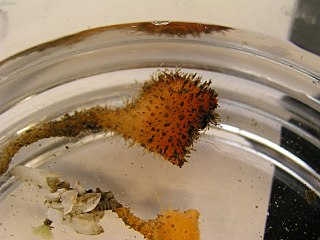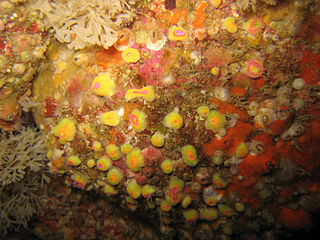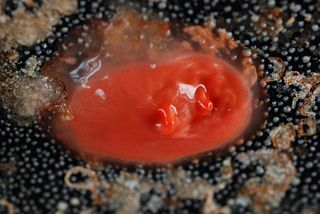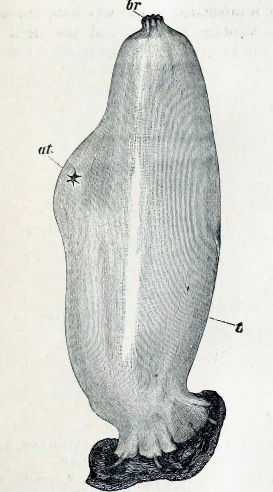
Herdmania is a genus of ascidian tunicates in the family Pyuridae.

Corella willmeriana is a solitary tunicate in the family Corellidae. It is native to the eastern Pacific Ocean where it lives on the seabed at depths down to about 75 m (250 ft) between Alaska and California.

Montagu's blenny, also known as the capuchin blenny, is a species of combtooth blenny found in the intertidal zones of the eastern Atlantic ocean from England to Madeira and the Canary Islands as well the Mediterranean Sea, the Black Sea and the Sea of Marmara. This species prefers rocky shores with much wave action. This species grows to a length of 7.6 centimetres (3.0 in) SL. It is the only species in the genus Coryphoblennius.

Thecacera pennigera, common name the winged thecacera, is a species of sea slug, a nudibranch, a shell-less marine gastropod mollusc in the family Polyceridae.

Didemnum vexillum is a species of colonial tunicate in the family Didemnidae. It is commonly called sea vomit, marine vomit, pancake batter tunicate, or carpet sea squirt. It is thought to be native to Japan, but it has been reported as an invasive species in a number of places in Europe, North America and New Zealand. It is sometimes given the nickname "D. vex" because of the vexing way in which it dominates marine ecosystems when introduced into new locations, however the species epithet vexillum actually derives from the Latin word for flag, and the species was so named because of the way colonies' long tendrils appear to wave in the water like a flag.
Perophora viridis, the honeysuckle tunicate, is a species of colonial sea squirt in the genus Perophora found in the tropical western Atlantic Ocean.

Molgula oculata, commonly known as the sea grape, is a species of solitary tunicate in the family Molgulidae. It is native to the north eastern Atlantic Ocean and the North Sea. The specific name oculata means "having eyes"; the species has orifices which "seem like dark eyes within a spectacle-formed frame".
Molgula occulta is a species of solitary tunicate in the family Molgulidae. It is native to the north eastern Atlantic Ocean, the North Sea and the Mediterranean Sea. The specific name occulta means "tailless" and refers to the tunicate's larva, which lacks the tail found in some other species in the genus Molgula.
Polycarpa fibrosa is a species of tunicate in the family Styelidae. It is brown and globular and its outer surface is covered with a mat of fibrils. It normally lies buried in soft sediment on the seabed with only its two siphons protruding. It occurs in the Arctic Ocean and northern Atlantic Ocean. P. fibrosa was first identified and described by the American malacologist William Stimpson in 1852.
Molgula citrina is a species of solitary tunicate in the family Molgulidae. It is found on both sides of the northern Atlantic Ocean and in the Arctic Ocean. In 2008 it was found in Kachemak Bay in Alaska, the first time it had been detected in the Pacific Ocean.

Polyclinum aurantium is a species of colonial sea squirt, a tunicate in the family Polyclinidae. It is native to shallow water in the northeastern Atlantic Ocean and Mediterranean Sea.

Cerianthus membranaceus, the cylinder anemone or coloured tube anemone, is a species of large, tube-dwelling anemone in the family Cerianthidae. It is native to the Mediterranean Sea and adjoining parts of the northeastern Atlantic Ocean.

Polycarpa pomaria is a species of tunicate or sea squirt in the family Styelidae. It is native to the northeastern Atlantic Ocean where it lives on the seabed at depths down to about 450 metres (1,500 ft).

Phallusia mammillata is a solitary marine tunicate of the ascidian class found in the eastern Atlantic Ocean and the Mediterranean Sea.

Boltenia villosa is a species of tunicate, a marine invertebrate of the family Pyuridae. Common names include the spiny-headed tunicate, the hairy sea squirt, the stalked hairy sea squirt and the bristly tunicate. This species was first described in 1864 by the American marine biologist William Stimpson who gave it the name Cynthia villosa. It was later transferred to the genus Boltenia. The type locality is Puget Sound, Washington state, United States.

Corynactis viridis, the jewel anemone, is a brightly coloured anthozoan similar in body form to a sea anemone or a scleractinian coral polyp, but in the order Corallimorpharia. It is found in the northeastern Atlantic Ocean and the Mediterranean Sea and was first described by the Irish naturalist George Allman in 1846.

Cnemidocarpa finmarkiensis is a species of solitary ascidian tunicate in the family Styelidae. Common names include broad base sea squirt, orange sea squirt, red sea squirt, shiny orange sea squirt, shiny red tunicate and Finmark's tunicate. It is native to shallow waters in the northern and northeastern Pacific Ocean.

Pyura haustor is a species of sessile ascidian, or sea squirt, that lives in coastal waters in the north-eastern Pacific Ocean, attached to rocks or artificial structures. Common names for this species include the wrinkled seapump, the wrinkled sea squirt and the warty tunicate.
Halocynthia igaboja, commonly known as the sea hedgehog, the bristly tunicate or spiny sea squirt, is a species of tunicate in the family Pyuridae. It is native to the northeastern Pacific Ocean. This species was first described in 1906 by the Japanese marine biologist Asajiro Oka, who gave it the name Cynthia ritteri. It was later transferred to the genus Halocynthia.

Phyllodoce lineata is a species of polychaete worm in the family Phyllodocidae. It is native to the northeastern Atlantic Ocean and the Mediterranean Sea where it occurs in the intertidal and shallow sub-tidal zones on soft sediment.
















